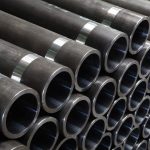Alloy steel is steel that is alloyed with a variety of elements in total amounts between 1.0% and
50% by weight to improve its mechanical properties. Alloy steels are broken down into two groups: low-alloy steels and high-alloy steels. The difference between the two is somewhat arbitrary: Smith and Has hemi define the difference at 4.0%, while Degarmo, et al., define it at
8.0%. Most commonly, the phrase “alloy steel” refers to low-alloy steels.
Types:
According to the World Steel Association, there are over 3,500 different grades of steel, encompassing unique physical, chemical and environmental properties.
In essence, steel is composed of iron and carbon, although it is the amount of carbon, as well as the level of impurities and additional alloying elements that determines the properties of each steel grade.
The carbon content in steel can range from 0.1-1.5%, but the most widely used grades of steel contain only 0.1-0.25% carbon. Elements such as manganese, phosphorus and sulphur are found in all grades of steel, but, whereas manganese provides beneficial effects, phosphorus and sulphur are deleterious to steel’s strength and durability.
Different types of steel are produced according to the properties required for their application, and various grading systems are used to distinguish steels based on these properties. According to the American Iron and Steel Institute (AISI), steels can be broadly categorized into four groups based on their chemical compositions:
1. Carbon Steels
2. Alloy Steels
3. Stainless Steels
4. Tool Steels


